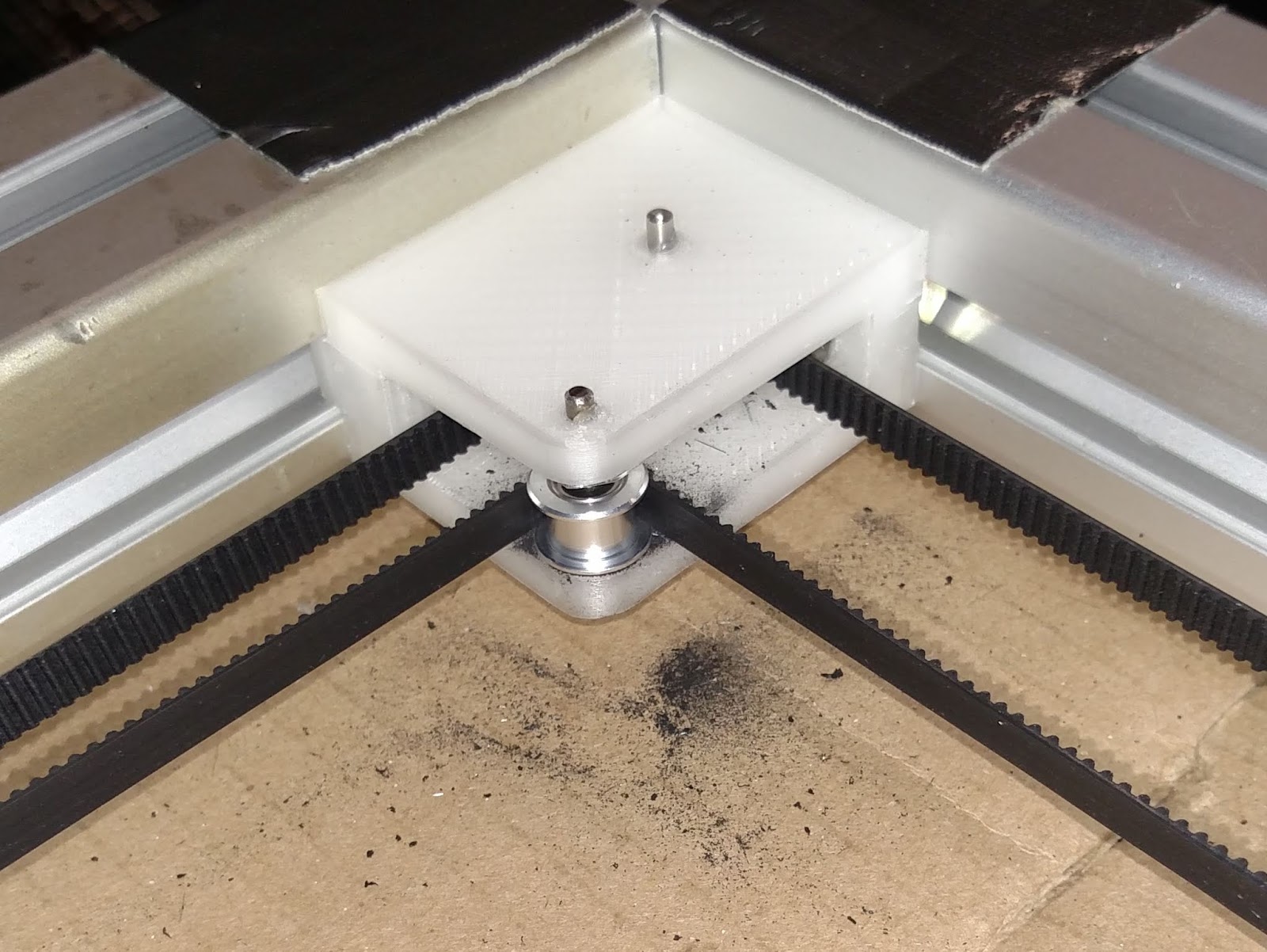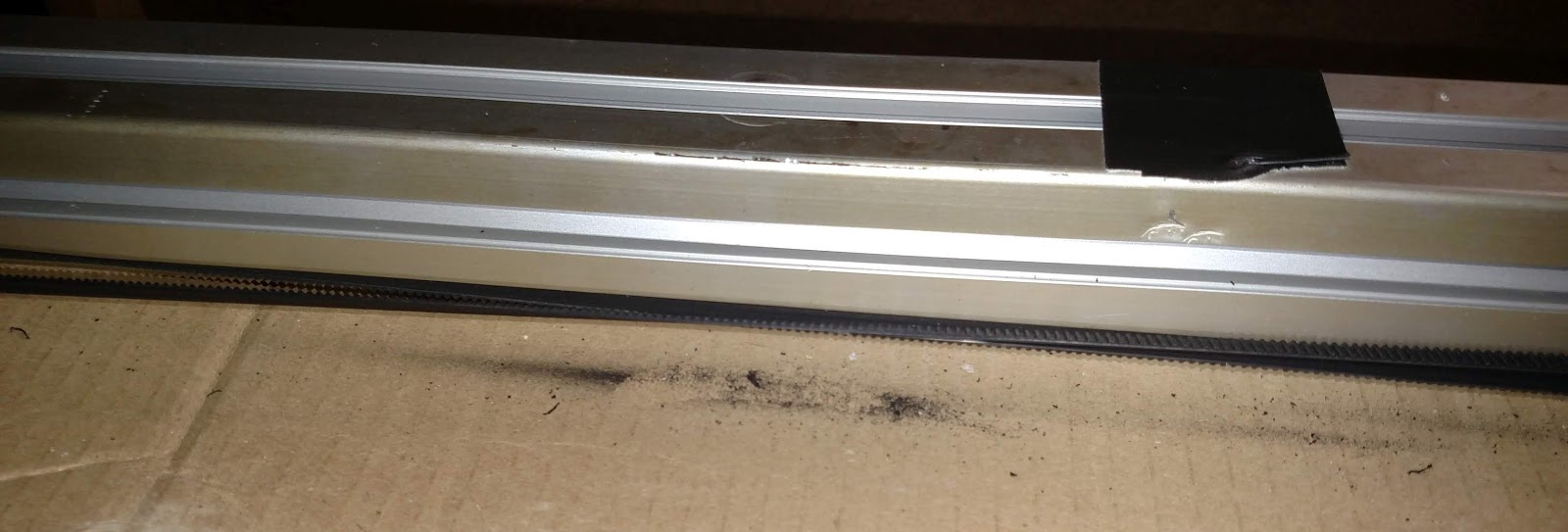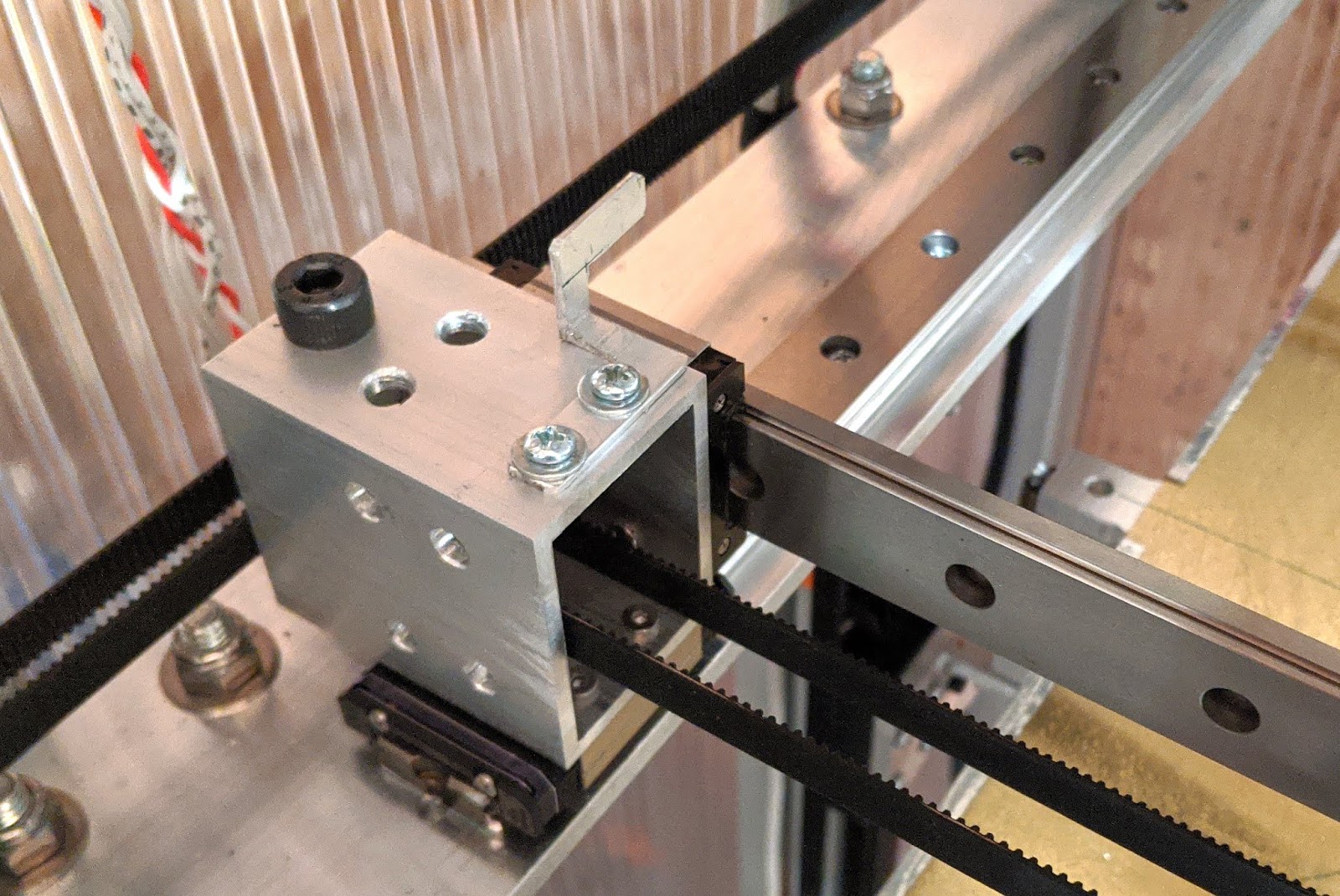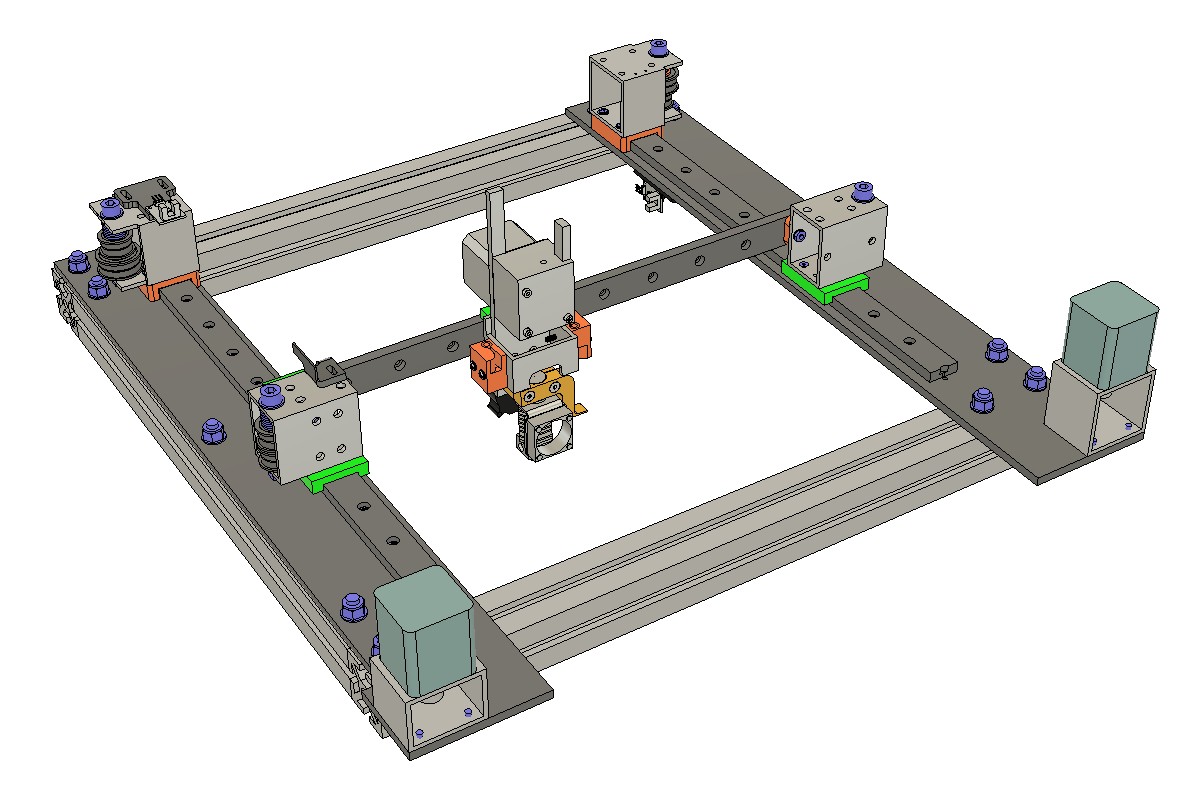Black Beauty Arises!
-
@bberger said in Black Beauty Arises!:
does anybody feel the long belt path of CoreXY adds additional noise from the belts over a cartesian/crossgantry design?
Maybe if you're really going fast there can be a bit of a zip zip zip sound, but at tame speeds it's quite silent for me.
-
@bberger said in Black Beauty Arises!:
- does anybody feel the long belt path of CoreXY adds additional noise from the belts over a cartesian/crossgantry design?
No.
-
I did a lot of work on making my sand table (approx 2m x 1 m), a stacked belt corexy mechanism, run quietly.The table has UHMW PE bearings sliding in t-slot rails in the Y axis, and PTFE bearings sliding on a powder coated aluminum tube in X axis. I typically run the table at 500 mm/sec with acceleration at 2k. I found two main sources of noise: the motors themselves and the belt teeth contacting smooth pulleys. I was able to quiet the NEMA-23 motors by stepping their speed up by 5x using pulleys and loop belts, and running 256:1 ustepping. The speed step up reduced the noise more than switching to 256:1 ustepping. The motors turn at 1.25 revs/sec even when the mechanism is running at 500 mm/sec. I quieted the belts (zip-zip) by twisting them so only smooth back sides of belts contact smooth pulley surfaces. At lower speeds everything makes less noise. High acceleration/jerk tends to make things noisy too as direction changes are accompanied by banging noises, so keep those numbers down to keep things quiet (but that amy reduce print quality).
Now I am finding that the cheesy 3D printer pulleys with tiny bearings are starting to squeak and it's really annoying. I'll be replacing them with pulleys made from larger ball bearings over the next couple weeks, and that will hopefully eliminate that source of noise.
I recently ordered a couple servomotors to try in the sand table to see if I can make it even quieter. They'll arrive some time in May if I'm lucky.
-
@bberger said in Black Beauty Arises!:
@gtj0 this may seem like an odd question, but it's one thing that's been actually bugging me:
How would you rate the noise levels of especially the belt paths between your cross gantry and corexy build?In the end, the total length is the same either way. In the XY Cartesian setup, it was 4 belts, each about 1170mm. In the CoreXY, it's for all intents and purposes, 2 belts, each about 2340mm. However, no single unsupported belt span exceeds 1170mm (the back 2 belts). So belt vibration itself I feel is actually less.
I'll get a demo rail of the 40x40 drylinN hopefully at Tuesday and if that actually works out on my Delta I may be ready to dive into an actual full Igus build..
I've been happily using Igus stuff for a decade now in various (non printer) projects and I've admittedly become a fan of their stuff and to be frank - right now I don't care if they can match Hiwin/TSK/IKO/etc precision. It's readily available to me, I can get it fast and for a reasonable enough price to just tinker with it. If it fails I'll just repurpose the stuff.Right now I'm just after an as-silent-as-possible printer that doesn't have to print at insane speeds. (as long as it can run overnight in our open living room I'm good). You've actually pulled off 2 different working gantry designs off Igus rails - that's good enough for me for now.
That leaves me with basically 2 concerns:
- noise from the belt
- noise from the motors themselves
Add noise from various fans

The plastic stuff should be good at dampening vibrations, so that's an added bonus.
I can only hear my rails if I turn everything off, remove the belts, close the windows, stick the cats in another room, and push the gantry and tool carriage by hand. And even then it's only a whisper.
By far the loudest part of my printer are the fans, with the motors coming second. Having said that, my living room and work area (well dining area
 ) are actually one big room and I can print at 100mm/sec and watch TV at the same time. Printing gap and short infill shakes things around a bit but that's the crappy table the printer is sitting on.
) are actually one big room and I can print at 100mm/sec and watch TV at the same time. Printing gap and short infill shakes things around a bit but that's the crappy table the printer is sitting on.I don't really care about cost too much on that build and I'm still undecided between going Makerbot gantry with dual Y motors (stealthchop2 on Moons motors) or corexy. I'm not looking at crazy acceleration or jerk values and if it's silent then I have no problem with it going 2 nights instead of one..
At this point, I simply wouldn't consider any other kinematics than CoreXY. The "complicated" belt design scares people off (as it did me initially) but you never have more than 1 motor per horizontal axis so as long as your gantry is aligned well to start and your belts are evenly tightened, it can't get out of true. The worst thing that can happen if a motor misses steps or fails is the tool carriage moves diagonally.
Long story short:
- does anybody feel the long belt path of CoreXY adds additional noise from the belts over a cartesian/crossgantry design?
CoreXY is quieter in my experience.
- I'd appreciate ANY tips/insights on Igus rails. Orientation, preload, number of carriages, anything to get me a headstart.
It's hard to recommend anything specific without seeing a specific design for the gantry and tool carriage. With the 40 series N rails I'm guessing you're going to use just 1 rail for the gantry with the flat closed side of the rail vertical? If so, 2 sliders spaced as far apart as practical would be ideal. If you can make one of the mounting holes for the sliders slightly oversized that will allow you to adjust the contact area and alignment. You could also make both holes slightly oversized so that the weight of the carriage holds the sliders straight in the rails while you tighten the mounting screws.
You're the single one person I know as of yet that pulled off an Igus based printer. I want to suck up any knowledge that you're willing to share

No problem!
-
So since I'm also creating a coreXY I have to ask what is the benefit of a one level CoreXY as to a two level one (So having to rotate the belts oposed to putting them at different Z height.
-
@Nemesis1782 In my case, I wanted the tool carriage gantry to be flat/horizontal rather than vertical. It was just an easier design for me.
Stacking pulleys or offset belts still seems more complicated to me. Harder to design/assemble. For instance, if you stack pulleys, you have to support the shaft at both ends the force from the top belt will tend to bend the assembly over. Just my opinions though.
-
@gtj0 thank you for taking your time and answering in detail!
The 40 drylinN series are an experiment for my Delta. I stupidly cheaped out on it with Machifit MGN12 clones and 2 of the 3 were disastrous. Even after careful cleaning and lubing they remain stuck. The one carriage that actually isn't stuck has play in it. Lesson learned.
Not sure what way I'd go on a coreXY with Igus, really mostly depending on the performance of the 40 series. Supported drylin W do seem like a nice option, especially as they have adjustable preload carriages available. But I also don't want to rule out drylin N 20-ish with a proper floating/fixed arrangement as I'd prefer a non-cantilevered mount for the hotend. Especially since I want to mount a Hemera on it. I have the advantage that Igus is readily available for private persons in my country with quick delivery. Genuine Hiwin are either super expensive or I'd have to wait 1 month from China or even longer from the US for usable robodigg clones..
I'm a tinkerer, so I need stuff available on hand that I can play with.. apart from the noise factor the most important decision for Igus..
-
If you put the belts on two levels, you can stack the pulleys so in theory, at least, use less space for the mechanism. The location of pulleys is critical to ensure that the belts run parallel to the guide rails, so by stacking the pulleys there are fewer places to have to worry about exact placement and fewer chances to do it wrong. Stacking the belts means you don't have to twist them and take extra measures to ensure minimal wear at the crossover point. I have found twisted belts tend to ride on the pulley flanges more than untwisted belts and that can result in wear on the belts. Belt teeth contacting smooth pulleys can make a zipping noise, but you have to be running the mechanism unrealistically fast for it to be noticeable.

That was in the sand table that is 1.7m x 0.75m between pulleys. Part of flange-riding may have been due to the weight of the belt making it sag, and part was probably due to the forces produced by the twist in the belts.
Similar wear at the belt crossing, back side against back side:

I recommend supporting pulley axles at both ends whether you stack the belts or not. It's easy to do with printed parts as shown in the above photos and not difficult if you use rectangular aluminum tubing (you can cut it with a hacksaw if you have to). It helps to have a drill press to drill the holes, or even better, a milling machine.

The aluminum tubes could easily be replaced by bulkier printed parts if you have absolutely no access to tools to cut and drill aluminum.

-
@gtj0 I'm also working on my own CoreXY design. The reason I did not choose to do the twisty thing is because I'm afraid of damaging the belts.
-
@Nemesis1782 It's definitely a valid concern. You can only do it if the span is long enough to allow a more gradual twist. The genuine Gates belts also help because they have Nylon face and
fiberglass cords. I also don't have the machining tools or skills to produce the required brackets.
-
@gtj0 I think it would be little trouble to design 3D printable brackets to replace the aluminum tubes. Just print with thicker walls and filleted inside corners to maximize rigidity.
-
@mrehorstdmd said in Black Beauty Arises!:
@gtj0 I think it would be little trouble to design 3D printable brackets to replace the aluminum tubes. Just print with thicker walls and filleted inside corners to maximize rigidity.
Sure! I didn't mean to imply that one approach was better than the other. I just meant that the approach I took was simpler for my situation and my liking.
-
Some questions on the Igus rails, for you. I've been following this for quite awhile (since the Hypercube Overkill thread on RepRap.org), but now I'm getting close to ripping off the motion platform. This has been quite the project, and become very impressive.
You mention using 17mm, and overmolded. The only 17mm option on their site is the solid plastic carriages only, and that looks like what I see if the few photos where they are clearly visible, which was on the previous printer. The other options are there for 27mm and 40mm, though.

While the original design more or less explains the rail and toolhead layout on your newer revision, based on your experience with these rails, would you foresee any problems with them used in more common cantilevered toolhead layout (provided the use of 2 X rails, spaced at least as far apart as the printhead's center of gravity is from the front rail)?
Did you opt for a fixed/floating mix on the X axis, or all 4 fixed?
-
@yellowedplastic said in Black Beauty Arises!:
Some questions on the Igus rails, for you. I've been following this for quite awhile (since the Hypercube Overkill thread on RepRap.org), but now I'm getting close to ripping off the motion platform. This has been quite the project, and become very impressive.
Thanks!
You mention using 17mm, and overmolded. The only 17mm option on their site is the solid plastic carriages only, and that looks like what I see if the few photos where they are clearly visible, which was on the previous printer. The other options are there for 27mm and 40mm, though.

Yep they are all 17mm and solid plastic. The 4 on the tool carriage and the 2 on each of the Y rails are the 40mm long non-floating versions. The slider in each of the Z rails are 30mm long non-floating. The 27 and 40mm wide versions were just too big for me.
While the original design more or less explains the rail and toolhead layout on your newer revision, based on your experience with these rails, would you foresee any problems with them used in more common cantilevered toolhead layout (provided the use of 2 X rails, spaced at least as far apart as the printhead's center of gravity is from the front rail)?
I'm trying to picture your arrangement. With a cantilevered toolhead, I'd expect the rails to be "vertical", one above the other with their open faces facing the front of the printer, yeah? Or am I thinking something different? A lot depends on the length of the unsupported span and the mass of the toolhead but the rails are stiffest in that orientation so I wouldn't expect a problem. You may want to think about using a single 40mm wide rail and carriage though.
Did you opt for a fixed/floating mix on the X axis, or all 4 fixed?
In my design all 4 are fixed but that's because I have the ability to adjust the center-to-center distance of the rails. I align the front X rail so it's square with the Y rails, then adjust the back X rail so the toolhead slides with consistent friction across the span and with no twisting.
-
@gtj0 said in Black Beauty Arises!:
I'm trying to picture your arrangement. With a cantilevered toolhead, I'd expect the rails to be "vertical", one above the other with their open faces facing the front of the printer, yeah? Or am I thinking something different? A lot depends on the length of the unsupported span and the mass of the toolhead but the rails are stiffest in that orientation so I wouldn't expect a problem. You may want to think about using a single 40mm wide rail and carriage though.
That's still up in the air a bit. I'm planning to implement a Frank Herrmann style tool changer, though any tool changer will be easier with a cantilevered head. I doubt I'll be putting more than 500g on it, but am aiming for much less. The whole machining thing is new to me, so I'll probably be spending some evenings learning and wasting aluminum at my makerspace, figuring out what's most practical to end up with. Two horizontal rails of 17mm, or one of 27mm or 40mm, should allow for the least weight with a lot of rigidity, and least alignment work (IE, make the whole axis out of one piece of aluminum, like E3D's/Jubilee's, with rail lips and screw holes, with most of the work done by CNC milling), so I would lean that way, for now.
Did you opt for a fixed/floating mix on the X axis, or all 4 fixed?
In my design all 4 are fixed but that's because I have the ability to adjust the center-to-center distance of the rails. I align the front X rail so it's square with the Y rails, then adjust the back X rail so the toolhead slides with consistent friction across the span and with no twisting.

-
@yellowedplastic said in Black Beauty Arises!:
@gtj0 said in Black Beauty Arises!:
I'm trying to picture your arrangement. With a cantilevered toolhead, I'd expect the rails to be "vertical", one above the other with their open faces facing the front of the printer, yeah? Or am I thinking something different? A lot depends on the length of the unsupported span and the mass of the toolhead but the rails are stiffest in that orientation so I wouldn't expect a problem. You may want to think about using a single 40mm wide rail and carriage though.
That's still up in the air a bit. I'm planning to implement a Frank Herrmann style tool changer, though any tool changer will be easier with a cantilevered head. I doubt I'll be putting more than 500g on it, but am aiming for much less. The whole machining thing is new to me, so I'll probably be spending some evenings learning and wasting aluminum at my makerspace, figuring out what's most practical to end up with. Two horizontal rails of 17mm, or one of 27mm or 40mm, should allow for the least weight with a lot of rigidity, and least alignment work (IE, make the whole axis out of one piece of aluminum, like E3D's/Jubilee's, with rail lips and screw holes, with most of the work done by CNC milling), so I would lean that way, for now.
Did you opt for a fixed/floating mix on the X axis, or all 4 fixed?
In my design all 4 are fixed but that's because I have the ability to adjust the center-to-center distance of the rails. I align the front X rail so it's square with the Y rails, then adjust the back X rail so the toolhead slides with consistent friction across the span and with no twisting.

Gotcha. So in that arrangement, you could go with either 2 smaller rails or one 40mm one. The 40mm rail makes alignment easy but it's heavier and you can't see through it. If you go with 2 rails, you'd use 2 carriages in the top rail and just 1 in the bottom rail. The bottom one could swivel to prevent binding.
-
@mrehorstdmd Interesting wear on the idler. Figures me a bit; would you agree that probably the debris there is cause by the belt rubbing over each other, with debris falling right down at the spot and another part at the idlers where the belts "Bend open"? Or do you think the wear is caused by the belt rubbing on the idlers itself?
@gtj0: did you notice any debris on your printer yet? You have the spacer in the middle that prevents the rubbing between the belts, so...
Also what is the minimum length you feel needed for the "twisting trick"?
I also do hard to figure out reading post if it is really better to have smooth idlers v.s toothed ones. Pffff. Feels to me that toothed idlers are not an issue because there is no load on them...
-
@QuintBrand It's hard to say. I suspect the belts rubbing on the flanges of the pulleys were causing some wear in addition to the belt to belt contact. Gates belts have nylon facing on the teeth, not the back side of the belt, so the belt on belt wear would still occur. In some machines that cross the belts on one level people add a plastic separator, usually PTFE, to keep the belts from sliding against each other.
-
@mrehorstdmd Ok, so your feeling is that wear was at three places: left and right Idlers and in the middle the belt contact. THX.
-
@QuintBrand said in Black Beauty Arises!:
@mrehorstdmd Interesting wear on the idler. Figures me a bit; would you agree that probably the debris there is cause by the belt rubbing over each other, with debris falling right down at the spot and another part at the idlers where the belts "Bend open"? Or do you think the wear is caused by the belt rubbing on the idlers itself?
@gtj0: did you notice any debris on your printer yet? You have the spacer in the middle that prevents the rubbing between the belts, so...
Also what is the minimum length you feel needed for the "twisting trick"?
I also do hard to figure out reading post if it is really better to have smooth idlers v.s toothed ones. Pffff. Feels to me that toothed idlers are not an issue because there is no load on them...
Oops, lost track here. Been too busy with other stuff.
Nope, no debris at either the center or the idlers and the printer's been very busy. I have a belt span of about 650mm and wouldn't attempt the twist with a span of less than maybe 550mm. I have no data to back that up though as I haven't tried any shorter spans. As for toothed vs smooth idlers... It's true that there's no drive load of course but the inward force of just the belt teeth on a smooth idler surface would seem to cause the teeth to compress and expand more than if the teeth were riding in mating grooves of a toothed idler. Whether this is an issue in real use I'm not sure. I went with the toothed ones because it just made sense to me.